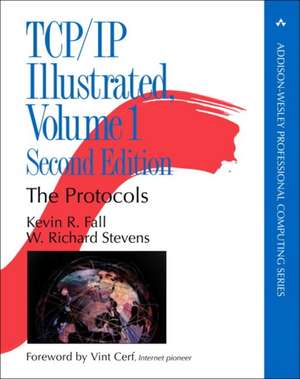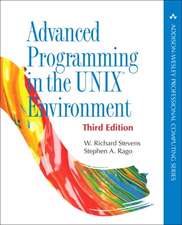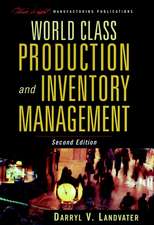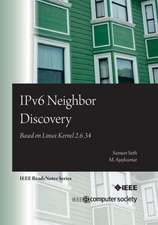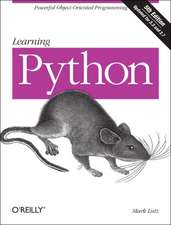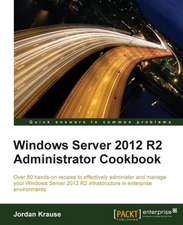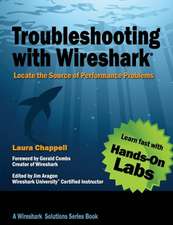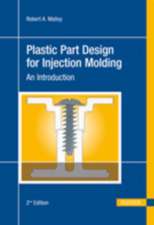TCP/IP Illustrated, Volume 1: The Protocols: Addison-Wesley Professional Computing Series
Autor Kevin R. Fall, W. Richard Stevensen Limba Engleză Hardback – 30 noi 2011
Preț: 441.58 lei
Preț vechi: 551.97 lei
-20% Nou
84.51€ • 87.90$ • 69.77£
Carte disponibilă
Livrare economică 25 martie-08 aprilie
Specificații
ISBN-10: 0321336313
Pagini: 1017
Ilustrații: illustrations
Dimensiuni: 185 x 236 x 40 mm
Greutate: 1.48 kg
Ediția:Nouă
Editura: Addison-Wesley Professional
Seria Addison-Wesley Professional Computing Series
Locul publicării:Boston, United States
Cuprins
Foreword xxv
Preface to the Second Edition xxvii
Adapted Preface to the First Edition xxxiii
Chapter 1: Introduction 1
1.1 Architectural Principles 2
1.2 Design and Implementation 8
1.3 The Architecture and Protocols of the TCP/IP Suite 13
1.4 Internets, Intranets, and Extranets 19
1.5 Designing Applications 20
1.6 Standardization Process 22
1.7 Implementations and Software Distributions 24
1.8 Attacks Involving the Internet Architecture 25
1.9 Summary 26
1.10 References 28
Chapter 2: The Internet Address Architecture 31
2.1 Introduction 31
2.2 Expressing IP Addresses 32
2.3 Basic IP Address Structure 34
2.4 CIDR and Aggregation 46
2.5 Special-Use Addresses 50
2.6 Allocation 62
2.7 Unicast Address Assignment 65
2.8 Attacks Involving IP Addresses 70
2.9 Summary 71
2.10 References 72
Chapter 3: Link Layer 79
3.1 Introduction 79
3.2 Ethernet and the IEEE 802 LAN/MAN Standards 80
3.3 Full Duplex, Power Save, Autonegotiation, and 802.1X Flow Control 94
3.4 Bridges and Switches 98
3.5 Wireless LANs-IEEE 802.11(Wi-Fi) 111
3.6 Point-to-Point Protocol (PPP) 130
3.7 Loopback 145
3.8 MTU and Path MTU 148
3.9 Tunneling Basics 149
3.10 Attacks on the Link Layer 154
3.11 Summary 156
3.12 References 157
Chapter 4: ARP: Address Resolution Protocol 165
4.1 Introduction 165
4.2 An Example 166
4.3 ARP Cache 169
4.4 ARP Frame Format 170
4.5 ARP Examples 171
4.6 ARP Cache Timeout 174
4.7 Proxy ARP 174
4.8 Gratuitous ARP and Address Conflict Detection (ACD) 175
4.9 The arp Command 177
4.10 Using ARP to Set an Embedded Device's IPv4 Address 178
4.11 Attacks Involving ARP 178
4.12 Summary 179
4.13 References 179
Chapter 5: The Internet Protocol (IP) 181
5.1 Introduction 181
5.2 IPv4 and IPv6 Headers 183
5.3 IPv6 Extension Headers 194
5.4 IP Forwarding 208
5.5 Mobile IP 215
5.6 Host Processing of IP Datagrams 220
5.7 Attacks Involving IP 226
5.8 Summary 226
5.9 References 228
Chapter 6: System Configuration: DHCP and Autoconfiguration 233
6.1 Introduction 233
6.2 Dynamic Host Configuration Protocol (DHCP) 234
6.3 Stateless Address Autoconfiguration (SLAAC) 276
6.4 DHCP and DNS Interaction 285
6.5 PPP over Ethernet (PPPoE) 286
6.6 Attacks Involving System Configuration 292
6.7 Summary 292
6.8 References 293
Chapter 7: Firewalls and Network Address Translation (NAT) 299
7.1 Introduction 299
7.2 Firewalls 300
7.3 Network Address Translation (NAT) 303
7.4 NAT Traversal 316
7.5 Configuring Packet-Filtering Firewalls and NATs 334
7.6 NAT for IPv4/IPv6 Coexistence and Transition 339
7.7 Attacks Involving Firewalls and NATs 345
7.8 Summary 346
7.9 References 347
Chapter 8: ICMPv4 and ICMPv6: Internet Control Message Protocol 353
8.1 Introduction 353
8.2 ICMP Messages 355
8.3 ICMP Error Messages 361
8.4 ICMP Query/Informational Messages 380
8.5 Neighbor Discovery in IPv6 395
8.6 Translating ICMPv4 and ICMPv6 424
8.7 Attacks Involving ICMP 428
8.8 Summary 430
8.9 References 430
Chapter 9: Broadcasting and Local Multicasting (IGMP and MLD) 435
9.1 Introduction 435
9.2 Broadcasting 436
9.3 Multicasting 441
9.4 The Internet Group Management Protocol (IGMP) and Multicast Listener Discovery Protocol (MLD) 451
9.5 Attacks Involving IGMP and MLD 469
9.6 Summary 470
9.7 References 471
Chapter 10: User Datagram Protocol (UDP) and IP Fragmentation 473
10.1 Introduction 473
10.2 UDP Header 474
10.3 UDP Checksum 475
10.4 Examples 478
10.5 UDP and IPv6 481
10.6 UDP-Lite 487
10.7 IP Fragmentation 488
10.8 Path MTU Discovery with UDP 493
10.9 Interaction between IP Fragmentation and ARP/ND 496
10.10 Maximum UDP Datagram Size 497
10.11 UDP Server Design 498
10.12 Translating UDP/IPv4 and UDP/IPv6 Datagrams 505
10.13 UDP in the Internet 506
10.14 Attacks Involving UDP and IP Fragmentation 507
10.15 Summary 508
10.16 References 508
Chapter 11: Name Resolution and the Domain Name System (DNS) 511
11.1 Introduction 511
11.2 The DNS Name Space 512
11.3 Name Servers and Zones 516
11.4 Caching 517
11.5 The DNS Protocol 518
11.6 Sort Lists, Round-Robin, and Split DNS 565
11.7 Open DNS Servers and DynDNS 567
11.8 Transparency and Extensibility 567
11.9 Translating DNS from IPv4 to IPv6 (DNS64) 568
11.10 LLMNR and mDNS 569
11.11 LDAP 570
11.12 Attacks on the DNS 571
11.13 Summary 572
11.14 References 573
Chapter 12: TCP: The Transmission Control Protocol (Preliminaries) 579
12.1 Introduction 579
12.2 Introduction to TCP 584
12.3 TCP Header and Encapsulation 587
12.4 Summary 591
12.5 References 591
Chapter 13: TCP Connection Management 595
13.1 Introduction 595
13.2 TCP Connection Establishment and Termination 595
13.3 TCP Options 605
13.4 Path MTU Discovery with TCP 612
13.5 TCP State Transitions 616
13.6 Reset Segments 625
13.7 TCP Server Operation 631
13.8 Attacks Involving TCP Connection Management 640
13.9 Summary 642
13.10 References 643
Chapter 14: TCP Timeout and Retransmission 647
14.1 Introduction 647
14.2 Simple Timeout and Retransmission Example 648
14.3 Setting the Retransmission Timeout (RTO) 651
14.4 Timer-Based Retransmission 664
14.5 Fast Retransmit 667
14.6 Retransmission with Selective Acknowledgments 671
14.7 Spurious Timeouts and Retransmissions 677
14.8 Packet Reordering and Duplication 682
14.9 Destination Metrics 685
14.10 Repacketization 686
14.11 Attacks Involving TCP Retransmission 687
14.12 Summary 688
14.13 References 689
Chapter 15: TCP Data Flow and Window Management 691
15.1 Introduction 691
15.2 Interactive Communication 692
15.3 Delayed Acknowledgments 695
15.4 Nagle Algorithm 696
15.5 Flow Control and Window Management 700
15.6 Urgent Mechanism 719
15.7 Attacks Involving Window Management 723
15.8 Summary 723
15.9 References 724
Chapter 16: TCP Congestion Control 727
16.1 Introduction 727
16.2 The Classic Algorithms 730
16.3 Evolution of the Standard Algorithms 739
16.4 Handling Spurious RTOs-the Eifel Response Algorithm 744
16.5 An Extended Example 745
16.6 Sharing Congestion State 767
16.7 TCP Friendliness 768
16.8 TCP in High-Speed Environments 770
16.9 Delay-Based Congestion Control 777
16.10 Buffer Bloat 781
16.11 Active Queue Management and ECN 782
16.12 Attacks Involving TCP Congestion Control 785
16.13 Summary 786
16.14 References 788
Chapter 17: TCP Keepalive 793
17.1 Introduction 793
17.2 Description 795
17.3 Attacks Involving TCP Keepalives 802
17.4 Summary 802
17.5 References 803
Chapter 18: Security: EAP, IPsec, TLS, DNSSEC, and DKIM 805
18.1 Introduction 805
18.2 Basic Principles of Information Security 806
18.3 Threats to Network Communication 807
18.4 Basic Cryptography and Security Mechanisms 809
18.5 Certificates, Certificate Authorities (CAs), and PKIs 821
18.6 TCP/IP Security Protocols and Layering 832
18.7 Network Access Control: 802.1X, 802.1AE, EAP, and PANA 833
18.8 Layer 3 IP Security (IPsec) 840
18.9 Transport Layer Security (TLS and DTLS) 876
18.10 DNS Security (DNSSEC) 894
18.11 DomainKeys Identified Mail (DKIM) 915
18.12 Attacks on Security Protocols 918
18.13 Summary 919
18.14 References 922
Glossary of Acronyms 933
Index 963
Notă biografică
Kevin R. Fall, Ph.D., has worked with TCP/IP for more than twenty-five years, and served on the Internet Architecture Board. He co-chairs the Internet Research Task Force's Delay Tolerant Networking Research Group (DTNRG), which explores networking in extreme and performance-challenged environments. He is an IEEE Fellow.
W. Richard Stevens, Ph.D. (1951-1999), was the pioneering author who taught a generation of network professionals the TCP/IP skills they've used to make the Internet central to everyday life. His best-selling books included all three volumes of TCP/IP Illustrated (Addison-Wesley), as well as UNIX Network Programming (Prentice Hall).
